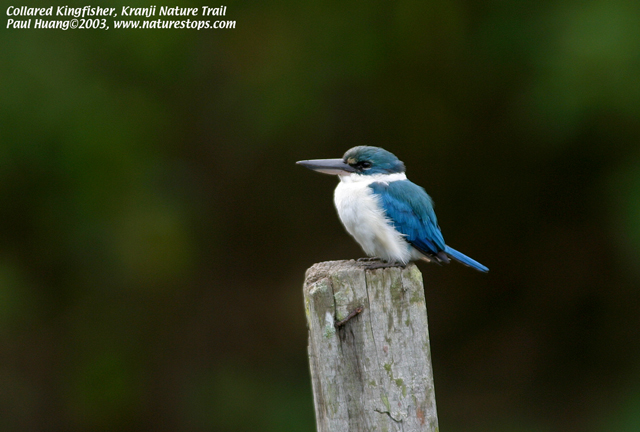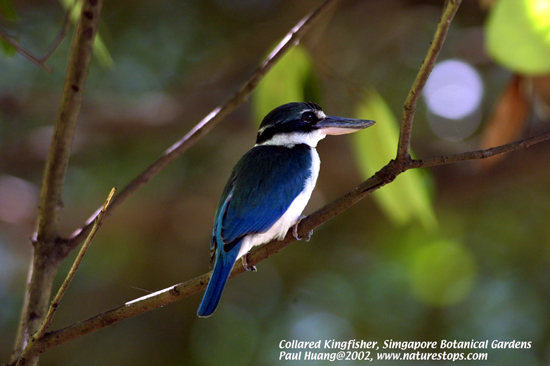Monkey has never been much of a birder. In fact, I was a serious disappointment at Fraser's Hill where all the bio grads were glued to binoculars and ooo-ing and aaa-ing at the great diversity of birds there.
However, being an avid reader of Prof Wee's bird ecology blog, I have begin to learn by osmosis and somehow, somewhere, I must have caught the bird flu... the birding flu that is!
Today when azurev and I were slacking having lunch at the grounds of St Andrews Cathedral, enjoying the vast greenery in the heart of the city, I suddenly saw a flash of azure.
No azurev didn't flash me but I saw azure wings reflecting in the sun and landed on a branch about 40m away from where we were seated - in front of the church. It had beautiful clear bright blue wings and pure white chest.
The first thought that came to mind was that WOW kingfisher! But what the heck are kingfishers doing in the heart of town?
I quickly prod azurev and after trying very hard and short of doing a printscreen and drawing an arrow on the bird, she finally spotted the bird. Just then, another of white-breasted bird landed 0.5m away from the first one, on the next branch. Wow, must be a couple. However, I cannot see the wings of the 2nd bird so I decided to walk forward to check them out.
It's hard to sneak up on 2 birds when there's no camoflague in sight. It's like a giraffe stalking a deer in the clear open grassland, without nothing to hide behind.
I walked relatively slowly and approached the tree on the other end of the field. (we were on opposite ends of the church ground or "field" if you prefer.) As I got about 10-15m away from the tree, I finally saw the blue wings of the 2nd bird to confirm that they are indeed a couple.
However, just then, the first bird and I made eye contact and he started to make the most raucous call ever! Indeed, I shall call it a squawk. It was so loud and immediately I know that he's trying to warn me away from his tree. Perhaps his nest is there?
Once he started squawking, I turned back and looked at azurev excitedly because I had made contact with the bird, despite a not-so-friendly one. I can tell from her expression that she's heard the squawking too which goes to show how loud it was. She described it as being as loud as a "fog horn".
Sadly, both of us did not have a camera on us, not even a camera phone. It's times like this that you wish you subscribed to the technological fervor.
Oh well, when I came back to the office and searched around online, the only bird I can find that looked even slightly like it was the white collared kingfisher (Halcyon chloris).
So far, all mention of this species I found online are of sightings at Kranji or Sungei Buloh. What was it doing at St Andrews Cathedral? Did it really have a nest on that tree? Or did it fly from the marina bay area and was stopping for a rest?
I did find a picture of the collared Kingfisher at the botanic gardens though.
In Ria's Mangrove and wetland wildlife at Sungei Buloh Wetlands Reserve, it writes this about the White Collared Kingfisher:The Collared Kingfisher is the most common Kingfisher in Singapore.
Collared Kingfishers are particularly aggressive. Not only towards their own kind, but also towards other Kingfisher species. This could be another reason for the widespread presence. The decline in the White-throated Kingfishers might also be due to the spread of the Collared.
They are also aggressive towards other birds such as mynas; vigorously driving off these birds from their feeding grounds, particularly during breeding season. They may even drive off landbound creatures.
The Collared Kingfisher is not considered at risk in Singapore. In the past, they were mostly found along the coasts and mangroves. But they have moved inland to hunt along freshwater wetlands, cultivated lands, gardens and parks. They usually avoid forests.
That surely explains why it was found in the garden of St Andrew Cathedral then and its agressive behavior towards me. I'm guessing now that the first bird is a male because mated males are supposed to be more blue than the females which is a lil more greenish.
I'll definitely go back again with a camera, just hope that it's still there for me when I go prepared!
Friday, January 20, 2006
The Birding Monkey
Posted by
Monkey
at
Friday, January 20, 2006
![]()
Labels: Nature

 I can be contacted at
I can be contacted at 







No comments:
Post a Comment